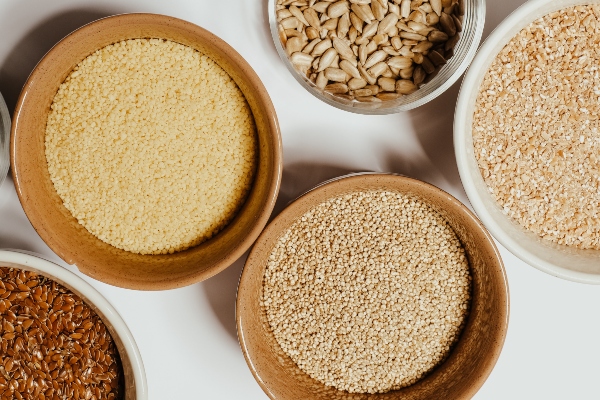A Recipe for Good Health
by Fran Werner
Whole grains — like bulgur, amaranth, buckwheat, quinoa and barley — have always been at the top of my list of favorite foods because they’re so delicious and versatile. But now I have even more reason to love them: New nutrition studies reveal that they cut heart disease risk by 21 percent and diabetes risk by 30 percent, and that antioxidants in grains reduce inflammation in the body, protecting against diseases like asthma and arthritis. They’re also rich in fiber and B vitamins. On top of all that, whole grains are digested slowly, so they keep you full longer, helping you keep your weight in check. You could get the recommended three daily servings of whole grains from whole-wheat bread and cold cereal, but why not try them in their natural form? If you follow these tips, your meals will be fast, easy and delicious.
Toast them first
This will add a depth of flavor to your dishes. Toast the grains in a sauté pan on top of the stove, or put them in the oven. Simply heat for a few minutes; remove when they start to give off a nutty aroma.
Vary the cooking liquid
Enhance your dish by using fruit juice (good if you’re having the grains for breakfast), broth (to give them a savory flavor) or even tomato juice (perfect with brown rice or bulgur). If you use water, toss in garlic, ginger or your favorite herbs to add some zip.
Spice them up
Grains take on the flavor of the ingredients they’re paired with, so pick a flavor combo you like — scallions, red pepper, broccoli and soy sauce for an Asian twist, for instance, or chickpeas, garlic, cumin, lemon and parsley for a Mediterranean slant — and start experimenting.
Pay attention to cooking times
Overcooked grains are mushy and bland. Many of them, like amaranth or quinoa, are ready in as little as 15 minutes; others, like barley and wheat berries, can take up to 45. Taste them close to the end of the cooking time — you want them to be slightly chewy, not soft. Improve their texture by fluffing: Run a fork gently through the grains, then cover and let sit five minutes before serving.
Serve them warm
Whenever I prepare grains, I cook more than I need for a recipe because they keep in the fridge, tightly covered, for up to five days. But bring them to room temperature or reheat them before serving. When chilled, the starches in grains harden and the flavors fade a bit.
Mushroom-Barley Casserole
1 Tbsp. margarine
1 (8 oz.) package pre-sliced mushrooms
1 (3 1/2 oz.) package shiitake mushrooms,
stems removed and caps sliced
1 cup uncooked pearl barley
1 (1 ounce) envelope onion soup mix
(such as Lipton’s)
4 cups water
Chopped chives (optional)
Directions
1. Preheat oven to 350 degrees.
2. Heat margarine in a medium nonstick skillet over medium-high heat. Add mushrooms; sauté five minutes or until tender. Set aside.
3. Combine barley, onion soup mix and water in a three-quart casserole, and stir in mushroom mixture.
4. Cover and bake at 350 for one hour and 15 minutes or until liquid is almost absorbed.
Garnish with chives, if desired.
Yield: 6 servings, 1/2 cup each.
Nutrition per serving: 161 calories, 2.5 grams fat, 4.4 grams protein, 31 grams carbohydrates, 6 grams fiber, 434 mg. sodium, 0 cholesterol.
Fran Werner is a certified lifestyle and weight management consultant, a certified personal trainer, and a certified lifestyle coach, specializing in weight management. She has been the owner/director of Lifestyle Consulting since 1981, and has maintained an office in Austin, Texas since 1993. Werner has helped thousands of individuals achieve and maintain healthy weights and healthy lifestyles. You can contact her at (512) 794-3848 or at stfh@lifestyleconsulting.com. Visit her Web site, www.lifestyleconsulting.com. Werner’s weight management program is now available on CD, www.thelifestyleprogram.com.






